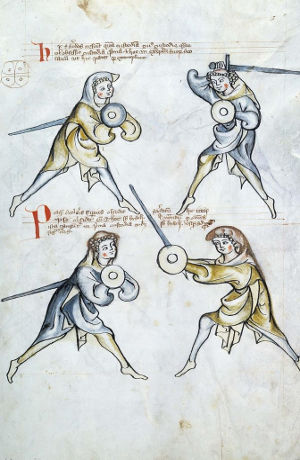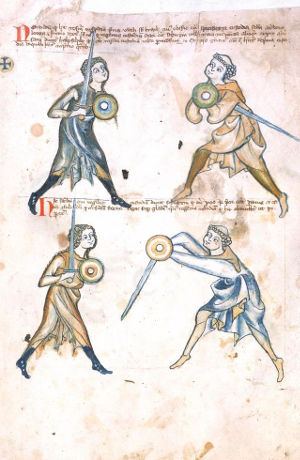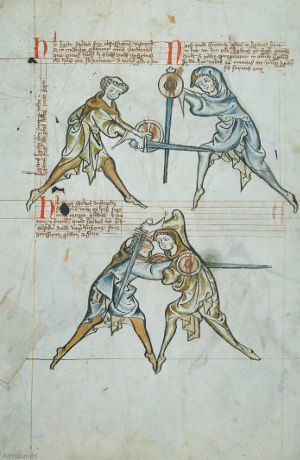Italian Rapier 
A buckler (French bouclier 'shield', from old French bocle, boucle 'boss') is a small shield gripped in the fist -- it was generally used as a companion weapon in hand-to-hand combat during the Middle Ages, as its size made it poor protection against missile weapons (e.g., arrows) but useful in deflecting the blow of an opponent's sword or mace. There are two major forms of medievally documented bucklers. The first is a simple round shield with the fist positioned directly behind the boss with a variety of shapes of face and depths of rim, similar to the bucklers illustrated in I.33. The second major form is a corrugated rectangle as suggested by Achille Marozzo in his Opera Nova. [1]





Spada e brocchiere training is limited to scholler students and above. The source of the material used for training sword & buckler at AEMMA is the MS I.33 treatise or Tower Fechtbuch. [2] This remarkable manuscript, simply entitled 'I.33' is comprised of 32 pages consisting of over a hundred ink-and-watercolour drawings, accompanied with Latin text describing the technique of sword & buckler combat. The original author is unknown to this day and the date of the manuscript is still in question, however, it has been dated to the late 13th century, and identified its owner as the secretary of Bishop of Würzburg. Much of the material studied can be sourced either in its original format in the AEMMA online library, or an excellent publication by Dr. Jeffrey Forgeng entitled "The Medieval Art of Swordsmanship - A Facsimile & Translation of Europe's Oldest Personal Combat Treatise, Royal Armouries MS.I.33", published by Chivalry Bookshelf, 2003. [3] [4]
The rationale for using the I.33 as the principle source for sword & buckler, is that it is the earliest known treatise on this fighting style, the commentaries offer enough contextual and conceptual detail to reconstruct this particular fighting style, and the illustrations offer visual information on the manner of execution of the guards and plays. The sword & buckler, although not explicity mentioned in Fiore's treatise, does create the opportunity for schollers to train in a fighting style which provides an excellent base for longsword training. Sword & buckler also emphasizes the physical mechanics of working with both hands together, and separately depending upon the situation. This is an important element in longsword training, that despite the sword being gripped by both hands, there are numerous situations in which one hand would leave the longsword grip, and engage with the opponent in giocco stretto plays. Sword & buckler also offers the schollers a relatively good defense for the hands in particular during real-time free-play bouts.
- Opera Nova ("A New Work") is a Bolognese fencing manual written by Achille Marozzo and printed in 1536.[1] This is the most extensive and significant treatise on the Dardi (or "Bolognese") style of Italian swordsmanship, as well as one of the most influential fencing manuals of the 16th century. source: Wiktenauer. Opera Nova (Achille Marozzo). Retrieved: January 18, 2017.
- The MS I.33 is a German fencing manual dating to the 1320s.[1] It currently rests in the holdings of the Royal Armouries at Leeds, United Kingdom. The I.33 is earliest extant treatise on Medieval martial arts, and it appears to have been devised by a secular priest, possibly the "Lutegerus" (or Liutger) mentioned in the text.[2] It was the work of three scribes and potentially as many as 17 illustrators. source: Wiktenauer. Walpurgis Fechtbuch (MS I.33). Retrieved: January 18, 2017.
- Jeffrey L. Forgeng, ed. and trans. The Medieval Art of Swordsmanship: A Facsimile & Translation of Europe’s Oldest Personal Combat Treatise, Royal Armouries MS. I.33 Union City CA: Chivalry Bookshelf, 2003. v+157pp. ISBN 1891448382. Retrieved: January 18, 2017.

